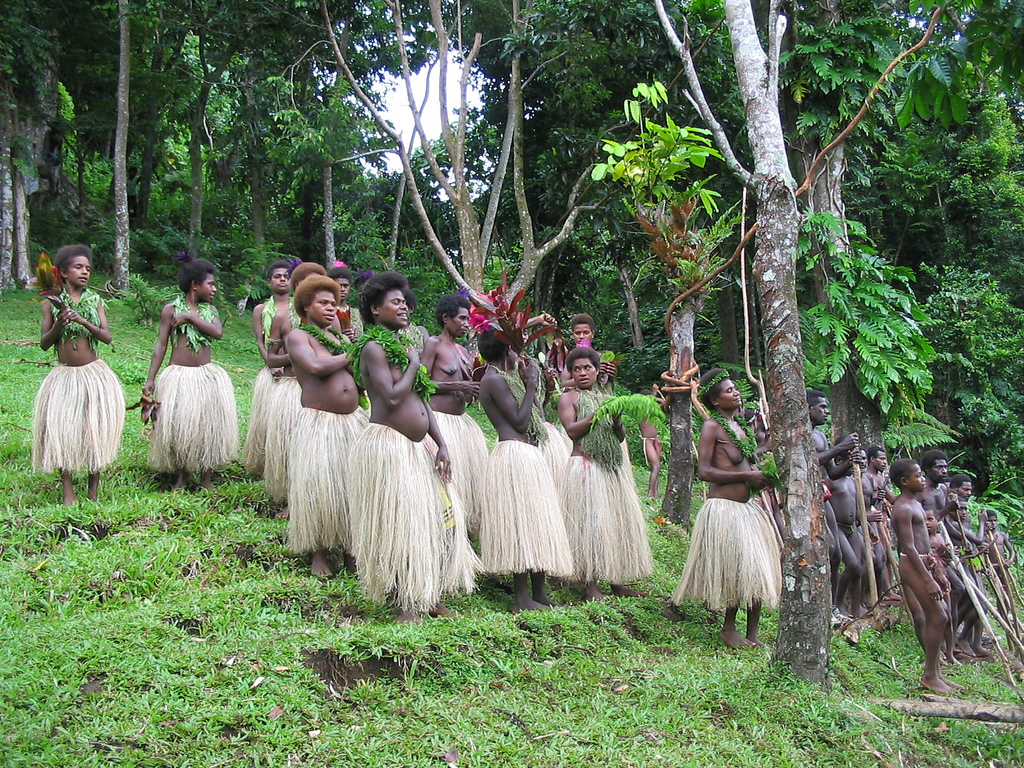Pentecost
Despite the fact that nowhere in the jungley interior of this long, thin island is more than a few hours walk from the coast, the villages of South Pentecost have preserved their traditions and tribal (un)dress better than almost anywhere else in Vanuatu, with the exception of certain parts of Espiritu Santo and Tanna. They are, however, very used to seeing tourists and more money-minded that anywhere else in the country. The reason: once a year boatloads of tourists arrive in South Pentecost to view one of the world’s most spectacular tribal festivals – that of Nanggol, or land-diving, the origin of modern bungee jumping. During this celebration of the yam harvest and right of passage for boys, thirty men spend five weeks building a 100 foot high wooden tower from which they “bungee jump” with a jungle vine wrapped around their ankle. The vines are specially selected for each boy to match his height, so that with his head tucked in his shoulders will brush the ground. If, however, you visit South Pentecost not between April and June you are unlikely to see a single other tourist.
Photo by meyerak on Flickr.
Pentecost island is remote and undeveloped. There are no towns, the only settlements being villages where most people are dependent on agriculture. There are not many trucks, motor boats, telephones or shops. A dirt track runs most of the way down the west coast but villages in the far south, on the wild east coast or in the mountainous interior remain isolated.
Kastom, local traditions and tribal dress have best been preserved in the interior of South Pentecost and on the South East coast, far from any roads or points where ships can dock. A high proportion of women in these parts wear only grass skirts and men only penis sheaths – a few leaves wrapped around their genitalia.
The Nanggol, as mentioned above takes place from April to June. Don’t expect to be able to turn up and watch it for free though – everywhere in South Pentecost, even more remote villages, very high fees are charged for watching it and even higher for videoing it. The High Chief of the area takes most of the money from this for himself and lives in a huge house in Port Vila.
Whatever you do, do not be tempted to offer people money to land dive at a time of year other than the usual. Queen Elizabeth 11 did that back in 1974 and one of the divers died because the jungle vines used were not yet supple enough.
You will also likely be charged just for entering any Kastom village in interior South Pentecost or on the East coast, such as Ratap or Bunlap. When I was there in 2008 the fee for this was 1000 vatu to enter a village or the ridiculous sum of 10,000 vatu to photograph it! This was the only part of Vanuatu where I encountered anything like this. That aside, the people are very friendly and will likely invite you to eat and drink kava with them. I was lucky enough to get invited to the opening of a new nakamal (men’s meeting house) in Ratap, to which hundreds of people came from the surrounding jungle and danced for three hours.
The north of Pentecost is less traditional than the south but the people may be less cash-savvy and affected by tourism.
There are two airports: Sara in the north and Lonorre in the south. Both receive three weekly flights from Port Villa and Luganville on Espiritu Santo, with brief stopovers on small islands such as Ambae and Maewo. Both passenger and cargo ships also stop on Pentecost’s west coast during the route Port Vila – Malekula – Espiritu Santo – Pentecost – Ambrym – Epi – Port Vila.
It is also possible to hire a motorboat, or get a place on one that is already going, between the closest points on Pentecost and Ambrym (Wanuru to Craig Cove) or Pentecost and Maewo (Laone to Asanvari).
There is no public transport so getting around Pentecost is about hiring your own truck (pretty expensive) or hitch hiking. I had no problems hitching lifts on trucks or finding a place on a boat already going to Ambrym, but I was lucky with the boat as I happened to catch a load of children going back to boarding school on Ambrym after spending the holidays witht their parents in Pentecost. If you don’t happen to be travelling around the beginning or end of school holidays but are intent on heading on to Ambrym you may have to hire your own motor boat with a local driver, or wait for the next cargo or passenger boat. A little knowledge of Bislama can only be an advantage as you can ask around with locals when the next truck or boat is going.
If planning on visiting the Kastom villages of interior South Pentecost or the east coast, you will need to get down the west coast dirt track to the village of Salap, your starting point, where there are a couple of very basic guest houses (wooden huts, hammocks, rats). I recommend the one owned by Luke, as I found him very helpful and honest. He also arranged a guide for me at a reasonable rate to take me into the interior.
From Salap you can trek through the jungles and mountains via Kastom villages such as Ratap and Longlibili to the Kastom village of Bunlap on the east coast.
Click here for my 2991 word blog on Pentecost island.

Leave a Reply